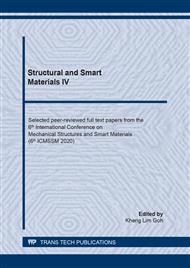[1]
K.Y. Luo, X. Jing, J. Sheng, G.F. Sun, Z. Yan, J.Z. Lu, Characterization and analyses on micro-hardness, residual stress and microstructure in laser cladding coating of 316L stainless steel subjected to massive LSP treatment, J. Alloys Compd. 673 (2016) 158-169.
DOI: 10.1016/j.jallcom.2016.02.266
Google Scholar
[2]
D.Z. Wang, Q.W. Hu, X.Y. Zeng, Residual stress and cracking behaviors of Cr13Ni5Si2 based composite coatings prepared by laser-induction hybrid cladding, Surf. Coat. Technol. 274 (2015) 51-59.
DOI: 10.1016/j.surfcoat.2015.04.035
Google Scholar
[3]
X.L. Yan, S.Y. Dong, B.S. Xu, Y. Cao, Progress and challenges of ultrasonic testing for stress in remanufacturing laser cladding coating, Mater. 11 (2018,) 293.
DOI: 10.3390/ma11020293
Google Scholar
[4]
C. Lee, H. Park, J. Yoo, C. Lee, W. Woo, S. Parrk, Residual stress and crack initiation in laser clad composite layer with Co-based alloy and WC+ NiCr, Appl. Surf. Sci. 345 (2015) 286-294.
DOI: 10.1016/j.apsusc.2015.03.168
Google Scholar
[5]
Y. Lu, G. Huang, Y. Wang, H. Li, Z. Qin, X. Lu, Crack-free Fe-based amorphous coating synthesized by laser cladding, Mater. Lett. 210 (2018) 46-50.
DOI: 10.1016/j.matlet.2017.08.125
Google Scholar
[6]
Y.F. Tao, J. Li, Y.H. Lv, L.F. Hu, Effect of heat treatment on residual stress and wear behaviors of the TiNi/Ti2Ni based laser cladding composite coatings, Opt. Laser Technol. 97 (2017) 379-389.
DOI: 10.1016/j.optlastec.2017.07.029
Google Scholar
[7]
Z. Zhao, L. Li, L. Tan, P. Bai, J. Li, L. Wu, H. Liao, Y. Cheng, Simulation of stress field during the selective laser melting process of the nickel-based superalloy, GH4169, Materials 11 (2018) 1525.
DOI: 10.3390/ma11091525
Google Scholar
[8]
C. Luo, J. Qiu, Y. Yan, J. Yang, C. Uher, X. Tang, Finite element analysis of temperature and stress fields during the selective laser melting process of thermoelectric SnTe, J. Mater. Process. Technol. 261 (2018) 74-85.
DOI: 10.1016/j.jmatprotec.2018.06.001
Google Scholar
[9]
X. Zhang, H. Li, S. Duan, X. Yu, J. Feng, B. Wang, Z. Huang, Modeling of residual stress field induced in Ti–6Al–4V alloy plate by two sided laser shock processing, Surf. Coat. Technol. 280 (2015) 163-173.
DOI: 10.1016/j.surfcoat.2015.09.004
Google Scholar
[10]
F.Z. Dai, J.Z. Lu, Y.K. Zhang, D.P. Wen, X.D. Ren, J.Z. Zhou, Effect of laser spot size on the residual stress field of pure Al treated by laser shock processing: Simulations, Appl. Surf. Sci. 316 (2014) 477-483.
DOI: 10.1016/j.apsusc.2014.07.166
Google Scholar
[11]
E.D. Derakhshan, N. Yazdian, B. Craft, S. Smith, R. Kovacevic, Numerical simulation and experimental validation of residual stress and welding distortion induced by laser-based welding processes of thin structural steel plates in butt joint configuration, Opt. Laser Technol. 104 (2018) 170-182.
DOI: 10.1016/j.optlastec.2018.02.026
Google Scholar
[12]
Y. Rong, G. Zhang, Y. Huang. Study on deformation and residual stress of laser welding 316L T-joint using 3D/shell finite element analysis and experiment verification, Int. J. Adv. Manuf. Technol. 89 (2017) 2077-2085.
DOI: 10.1007/s00170-016-9246-4
Google Scholar
[13]
Y. Chew, J.H.L. Pang, G. Bi, B. Song, Thermo-mechanical model for simulating laser cladding induced residual stresses with single and multiple clad beads, J. Mater. Process. Technol. 224 (2015) 89-101.
DOI: 10.1016/j.jmatprotec.2015.04.031
Google Scholar
[14]
P. Farahmand, R. Kovacevic, An experimental-numerical investigation of heat distribution and stress field in single-and multi-track laser cladding by a high-power direct diode laser, Opt. Laser Technol. 63 (2014) 154-168.
DOI: 10.1016/j.optlastec.2014.04.016
Google Scholar
[15]
M. Krzyzanowski, S. Bajda, Y. Liu, Triantaphyllou A, Rainforth W M, Glendenning M. 3D analysis of thermal and stress evolution during laser cladding of bioactive glass coatings[J]. J. mech. behav. biomed. mater. 59 (2016) 404-417.
DOI: 10.1016/j.jmbbm.2016.02.023
Google Scholar
[16]
K.A. Khor, Y.W. Gu, Effects of residual stress on the performance of plasma sprayed functionally graded ZrO2/NiCoCrAlY coatings, Mater. Sci. Eng., A 277 (2000) 64-76.
DOI: 10.1016/s0921-5093(99)00565-1
Google Scholar
[17]
Y.Gan, Z.L. Tian, H. Dong, China materials engineering ceremony(Vol.3), Chemical Industry Press, Beijing, 2006. (in Chinese).
Google Scholar
[18]
P. Farahmand, R. Kovacevic. Laser cladding assisted with an induction heater (LCAIH) of Ni-60% WC coating, J. Mater. Process. Technol. 222 (2015) 244-258.
DOI: 10.1016/j.jmatprotec.2015.02.026
Google Scholar
[19]
S. Zhou, J. Lei, X. Dai, A comparative study of the structure and wear resistance of NiCrBSi/50 wt.% WC composite coatings by laser cladding and laser induction hybrid cladding, Int. J. Refract. Met. Hard Mater. 60 (2016) 17-27.
DOI: 10.1016/j.ijrmhm.2016.06.019
Google Scholar


